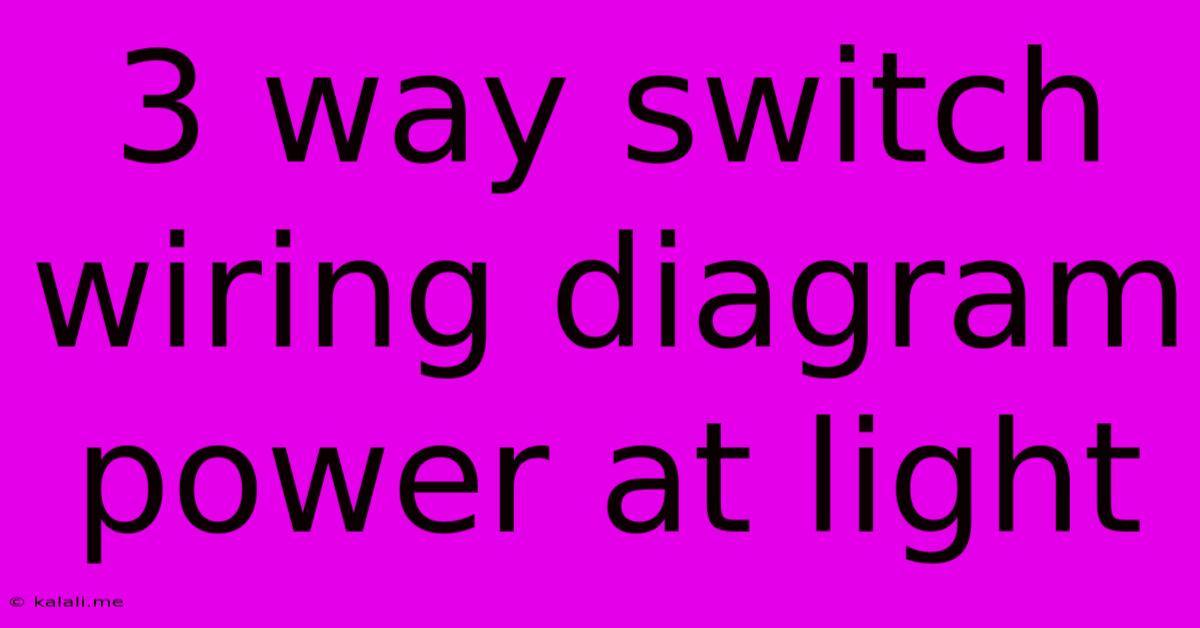3 Way Switch Wiring Diagram Power At Light
Kalali
May 22, 2025 · 3 min read

Table of Contents
3-Way Switch Wiring Diagram: Powering Your Lights with Style and Efficiency
This guide will walk you through the intricacies of a 3-way switch wiring diagram, specifically focusing on scenarios where the power source is connected to the light fixture itself. Understanding this setup is crucial for controlling lights from two different locations, offering unparalleled convenience and control in homes and offices. This is a common setup for staircases, hallways, or any area needing dual-point illumination control. We'll explore the wiring diagram, common mistakes to avoid, and troubleshooting tips to help you master this essential electrical skill.
Understanding the 3-Way Switch System
Unlike a standard single-pole switch, a 3-way switch uses two switches to control a single light fixture. This allows you to turn the light on or off from either switch location. The key is understanding the unique wiring configuration that facilitates this dual-control functionality. The power source connects directly to the light fixture, simplifying the circuit and often making installation slightly easier than other configurations. This diagram shows the most common method for this setup.
Wiring Diagram: Power at the Light
This is a simplified diagram; the actual wires might have different colors depending on your regional wiring codes. Always check your local codes and use caution when working with electricity.
Power Source (Hot Wire)
|
|
+---Neutral Wire (White) to Light Fixture
|
+---Traveler Wire (Black or Red) to Switch 1
|
Switch 1 (Common - Black/Darker, Traveler - Red/White)
|
+---Traveler Wire (Black or Red) to Switch 2
|
Switch 2 (Common - Black/Darker, Traveler - Red/White)
|
+---Light Fixture (Black or Red)
|
+---Ground Wire (Bare Copper or Green) to Light Fixture and Switches
Understanding the Components:
- Power Source (Hot Wire): This is the live wire bringing power to the system. In this configuration, it's directly connected to the light fixture's neutral wire.
- Neutral Wire (White): This carries the return current to complete the circuit. It's directly connected to the power source and the light fixture.
- Traveler Wires (Black or Red): These wires connect the two 3-way switches. The current flows through these wires depending on the switch positions. The color coding isn't strictly standardized, so double-check your wires carefully.
- Common Terminals (Black/Darker): These terminals are located on each switch and are connected to the power source or the light.
- Light Fixture: This is the device being controlled. Ensure it's correctly wired and grounded.
- Ground Wire (Bare Copper or Green): This ensures safety by providing a path for stray currents. Always connect this wire securely.
Common Mistakes to Avoid:
- Incorrect Wire Connections: Double-check each wire connection before turning the power back on. A single misplaced wire can lead to a malfunctioning circuit or even a safety hazard.
- Ignoring Grounding: Never skip grounding. It's a vital safety measure.
- Confusing Traveler Wires: Incorrectly wiring the traveler wires will prevent the switches from working correctly. Pay close attention to the diagram.
- Using the Wrong Type of Switch: Make sure you're using 3-way switches, not single-pole switches.
Troubleshooting Tips:
- Check the Power Source: Confirm that power is reaching the circuit breaker.
- Inspect the Wires: Look for any loose or damaged wires.
- Test the Switches: Ensure that both switches are functioning correctly.
- Verify the Light Fixture: Make sure the light bulb is working and properly installed.
Conclusion:
Wiring a 3-way switch with power at the light fixture offers a clean and efficient solution for controlling lights from two separate locations. By carefully following the wiring diagram and paying attention to the important details, you can easily install and troubleshoot this common electrical setup. Remember to prioritize safety and always consult a qualified electrician if you're unsure about any aspect of electrical work.
Latest Posts
Latest Posts
-
How Do You Switch Off Iphone 7
May 22, 2025
-
Getting Rid Of Mold On Bathroom Ceiling
May 22, 2025
-
Beer In The Freezer How Long
May 22, 2025
-
The Rabbit Is Out Of The Hat
May 22, 2025
-
French Movies With English And French Subtitles
May 22, 2025
Related Post
Thank you for visiting our website which covers about 3 Way Switch Wiring Diagram Power At Light . We hope the information provided has been useful to you. Feel free to contact us if you have any questions or need further assistance. See you next time and don't miss to bookmark.